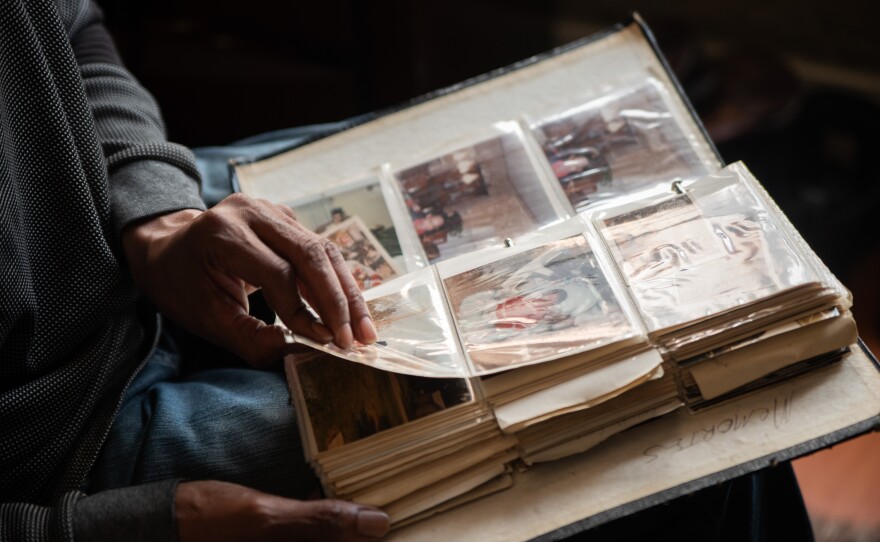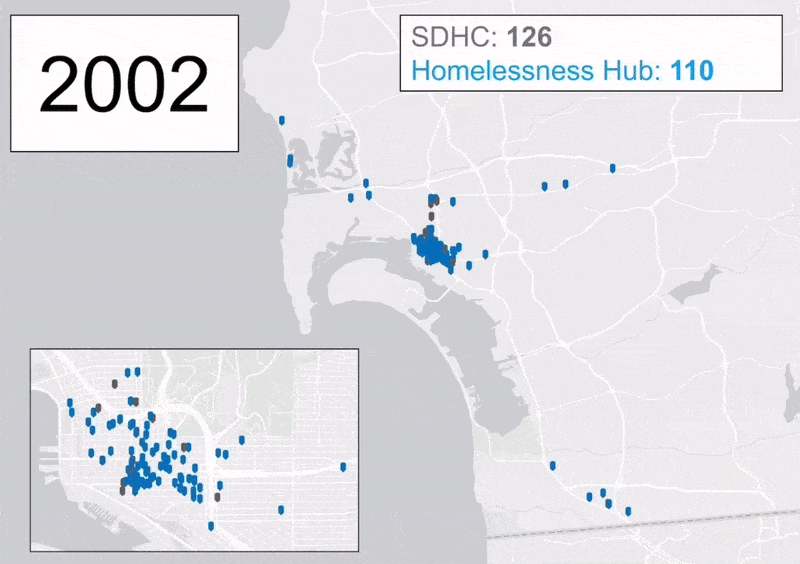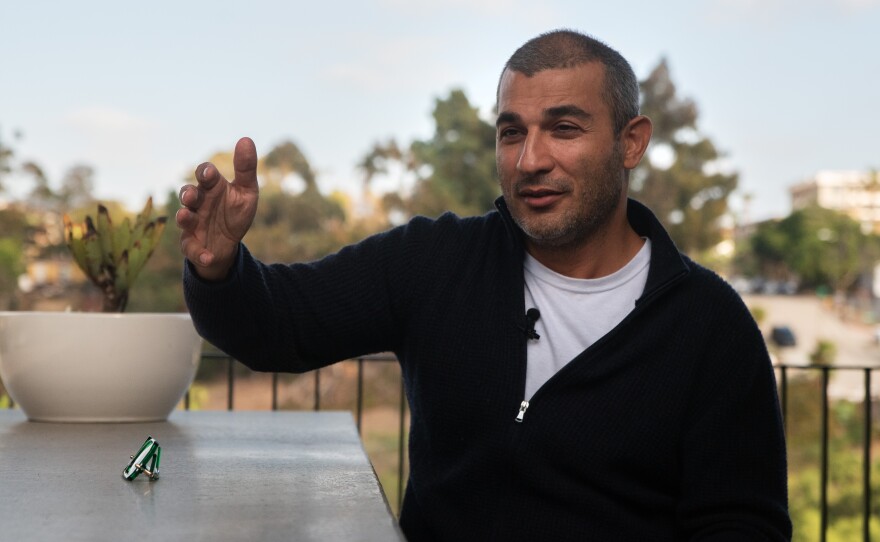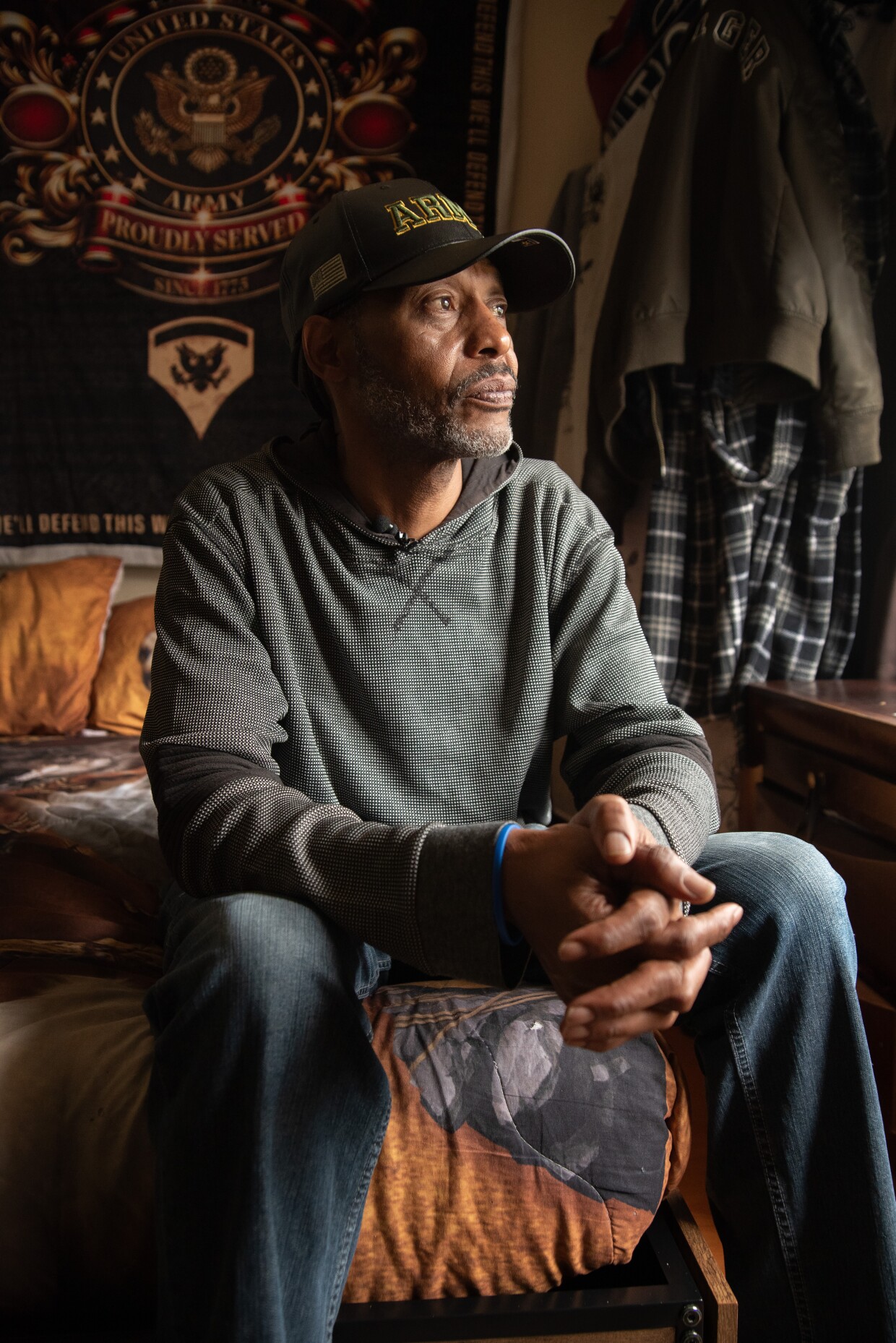Calvin Neal feels something like survivor’s guilt.
After three years of homelessness, he now occupies one of the city's few remaining single-room occupancy (SRO) units, in the Hotel Churchill in downtown San Diego.
He looks out his window at a luxury condominium building being built across the street. One of the condos is being sold for just under $2 million. The building will have a pet spa.
On the sidewalk below his window, homeless San Diegans figure out how to survive the day.
“I think sometimes that I would rather somebody out there got this,” he said in the quiet of his room. “I think I would probably be willing to be homeless again if I could do that.”
The smell of incense fills the small room that contains his entire life.
Across from Neal’s bed hangs a saying: “I have done things that haunt me at night so you can sleep in peace. I have been away from my family for a long time so you can be safe with yours. I have sacrificed a lot in my life so you can live in freedom. I have done these things because I swore an oath to my country. And I will live by the oath until the day I die. Because I am, and always will be, a U.S. veteran."
Neal was a combat medic in the military. He said he tried to find work in hospitals after he returned home, but couldn’t, so he worked security jobs instead.
Until one day, he was laid off. He missed a paycheck and that month’s rent. An eviction notice appeared on the door of his downtown San Diego apartment. He spent the next three years homeless.
He uses the same two words to describe his time in the Gulf War as his time on San Diego’s streets — ”not good.”
The ground was “terrible.” Bugs were “terrible.” But what bothered him the most is how people would just walk past him, even in his veteran’s hat.
“How could I go from serving the country to here?” he wondered. “And why doesn’t anyone care about it?”
Neil said because he fought in a war — the Gulf War — he was fast-tracked for a veteran housing voucher, and placed in the Hotel Churchill when it opened.
The city already owned the WWI-era hotel. Nine years ago, they renovated it into affordable SROs.
On the scale of SROs in San Diego, The Hotel Churchill is the Ritz-Carlton. Its small rooms have bathrooms and kitchens, and there are communal spaces and on-site social services. The units are set aside for veterans, transitioning foster youth and people recently released from incarceration.
A typical SRO is like a dorm room. Tenants often share a bathroom or kitchen down the hall. The average size in San Diego is 200 square feet, like a one-car garage. They can be poorly managed. Some are overrun by roaches, tenants say. A fridge might break and not be fixed until the groceries have already spoiled. And though they’re often occupied by people with disabilities, they’re not often laid out well for mobility devices.
But because of those downsides, SRO rent is usually the lowest in the market — anywhere from $750 to $1,300 a month. And there are usually less barriers to renting them — no credit checks or security deposits.
They are the most accessible housing in one of the most expensive markets in the country.
When Neal moved into his SRO, he looked forward to resting the most. He wanted to lay down on a bed. To be alone for once. To do whatever he wanted, for however long he wanted.
The room, however small, offered peace that felt impossible to find on the streets or in shelters.
“Away from the turmoil and all of that. You know? And it just, it's just good to have somewhere to be, you know? Go out into the world. Have a bad day. Come in here and I'm fine after a while,” he said.
Behind a door that locks, Neal could set down all the things he’d been literally carrying on his back for years. Put his books on a shelf. Hang family photos on the wall.
Clean running water meant he could return to the familiar cleanliness and order the military drilled into him.

For the tenants lucky enough to get placed in them, SROs can be life-changing.
Well into the 20th century, they were widely available in big cities. But by the 1960s, public opinion began to turn.
“SROs had a real negative connotation,” said Stacey Livingstone, researcher for UC San Diego’s Homeless Hub. “They were seen as housing that essentially, like, outsiders lived in, transients, folks who didn't want to work, folks who didn't want to get married.”
Society labeled SROs as a “blight.”
When cities started pushing for “urban renewal,” they destroyed SRO buildings.
Livingstone said when San Diego “revitalized” Horton Plaza and the Gaslamp Quarter in the ‘80s, it lost a quarter of its SRO stock at once.
People were pushed out of SROs and onto the street. The so-called “blight” of poverty became even more visible.
It was a wake-up call for the City of San Diego. Councilmembers passed an emergency ordinance in the ‘80s to try to preserve the SRO buildings that remained. It didn’t work.
By 2002 there were only 110 SRO buildings left, according to UCSD data. By 2023, that had dropped to just 35.

Meanwhile, the city’s homeless population had exploded to more than 6,500 people.
Livingstone said the legacy of SRO stereotypes remains today.
“There are ideas that these are people living with substance use issues. There are ideas that these are people who don't really want to work or have a family, that are disconnected from traditional work and family roles. These are deeply historical stereotypes, and they really don't reflect the reality of who's living in SROs in San Diego,” she said.
She said most SRO occupants are seniors and people with disabilities who live on fixed incomes, people leaving homelessness, and the minimum wage workers who keep downtown running.
In the current housing affordability crisis, the city has prioritized SROs again.
Mayor Todd Gloria introduced incentives for developers to build more of them. Projects that include SROs can win exemptions from certain zoning restrictions.
But KPBS found that since those incentives passed two years ago, the number of new SRO units permitted is zero.
Local developer, Soheil Nakhshab, said asking why those incentives haven’t worked yet is the wrong question.
“I think the question you should be asking is more, ‘Is it affordable to develop anything right now?’ Costs are just astronomically out the roof for construction materials and labor. Interest rates are high, land prices are out the roof, too,” he said.

A few years ago, Nakhshab built microapartments in the East Village. They’re about the same size as SROs. He rents them for about $1,800 a month. Still, he said he can’t even justify a project like that anymore.
“If I were to build that building today, it's going to cost me 30% or 40% more than it did three years ago. That's a crazy hike in cost,” he said.
He said for developers to rent new units at SRO rates would be impossible.
“They would need to go more market rate so they can survive. I mean, they've taken all this risk. They've put up all this equity. They've got investors that they have to answer to,” he said.
He said to make SROs appealing to build, the city would need to offer even more drastic incentives. No development or permit fees. Even less regulation.
Renovating existing SRO buildings can also be unprofitable. They tend to be about a century old. Renovation costs are high, but rent is low. It often makes more sense to tear it down and build something newer, bigger and denser — with higher rents.
The San Diego Housing Commission (SDHC) wants to try a new tactic.
They pitched the City Council to create an Affordable Housing Preservation Fund. The council will vote on it later this fall.

It would pull together government dollars and private donations to buy up properties and keep their rents affordable for the long term.
Colin Miller is SDHC’s vice president of real estate. He said the fund could also help landlords keep existing affordable housing affordable.
“‘Hey, we were built 1920. We need a new roof.’ And they don't have enough revenue from the rents they charge because they're below market to afford a new roof. And that's where we can come in and help preserve that building and keep people living in their homes,” he said.
The city has been trying a slew of strategies to encourage more affordable housing: fast-tracking permits; creating new incentives; funding construction directly.
It is working to increase housing stock. But units the city deems “affordable” can rent for more than $2,000 a month — twice the rent of a typical SRO.
That price puts them out of reach for many who have nowhere else to go, like Calvin Neal.
From a karaoke speaker in the corner of his SRO, he plays music like his mom used to on Saturdays — R&B, country and her favorite, Latimore’s “Take Me to the Mountaintop.” He remembers the good times with her.
He said he can think better here. He can unpack his past — his kids, his family and “military stuff.”
“That always stays in my brain for some reason,” he said.
He can also plan for the future. There’s a guitar in the corner he hopes to one day play like his dad did. On the fridge is an oath he swore to himself when he was still homeless: “Through my deeds, I will take control of my life and be the best man I can possibly be to myself and others.”
Neal has become a staple in the community that’s forming between tenants here.
He helps them clean, take the trash out and run errands.
“That really makes me feel good,” he said. “It helps me out, too.”
Slowly, neighborly relationships are replacing the isolation he felt on the streets.
The high-rise continues to stack up across the street, preparing for future tenants who can afford a $2-million condo. The people on the sidewalk below continue to chase survival. And the realities of San Diego’s housing market continues to widen the gap between them.





